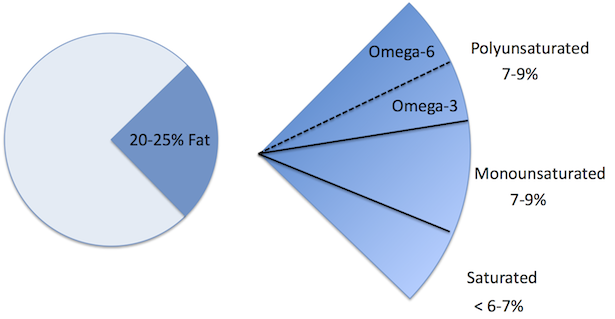Polyunsaturated fat is a type of unsaturated fat. In general, this class of fats has a beneficial effect on your heart when eaten in moderation and when used to replace saturated fat and trans fat in your diet. From a chemical standpoint, polyunsaturated fat is simply a fat molecule that has more than one unsaturated carbon bond, also called a double bond, in the molecule.
Types of Polyunsaturated Fat
The two basic types of polyunsaturated fat most commonly associated with health and the human diet are omega-3 and omega-6 fats. Both of these fats are essential and healthy in moderation. While omega-6 fats are healthy in moderation, excessive consumption of omega-6 fats in proportion to omega-3 fats may increase the risk of heart disease, diabetes, and cancer.
Read on to learn more about the differences between omega-3 and omega-6 fats as well as sources for each type.
Omega-3 Fats
Omega-3 fatty acids, consumed in moderation, provide important health benefits. The brain and the body depend on them for fuel, and they protect against heart disease, reduce inflammation, and boost brainpower. Research has shown that these fats also decrease the risk of arrhythmias (abnormal heartbeats), decrease triglyceride levels, slow the growth rate of atherosclerotic plaques, and lower blood pressure (slightly).1-2 Furthermore, omega-3 fatty acids have been shown to reduce wrinkles.
Omega-3 fatty acids are essential in the diet, as the body cannot make them. Humans must acquire them from food.
Omega 3 Foods (Plant Sources) |
| Flaxseed |
| Hempseed |
| Pumpkin Seed |
| Walnuts |
Omega 3 Foods (Animal Sources) |
| Salmon |
| Mackerel |
| Herring |
| Trout |
| Sardines |
| Tuna |
| Eggs |
Omega-6 Fats
Omega-6 fatty acids are another type of essential polyunsaturated fat found in seed oils such as corn, soybean, safflower, sunflower, and cottonseed oil. As previously stated, these fats are essential and healthy in moderation. Nevertheless, excessive consumption of this type of fat in proportion to omega-3 fats may increase the risk of heart disease, diabetes, and cancer. (Studies have shown that a ratio of omega-6 to omega-3 fatty acids of less than 4 to 1 is contributive to health.3)
Unfortunately, omega-6 fats possess a longer shelf life than omega-3 fats. Consequently, most processed foods contain this type of fat to extend their shelf lives. Therefore, eating large amounts of processed foods can result in an excess intake of omega-6 fatty acids.
Unfortunately, “Western diets” contain high intakes of corn-fed meats and processed foods, yielding an omega-6 to omega-3 ratio closer to 20 : 1. To improve this ratio and overall health, the best path to follow is simply to incorporate more omega-3 sources into one’s diet and limit the consumption of processed foods.
Fat Caloric Breakdown
Below is the recommended dietary consumption breakdown with respect to fats provided by the American Heart Association. As you can see polyunsaturated fat should comprise roughly 7-9% of caloric intake of roughly 17-22 grams based a 2200 calorie diet.


External Resources: American Heart Association: Polyunsaturated Fat
1. Leaf A. Prevention of sudden cardiac death by n-3 polyunsaturated fatty acids. J Cardiovasc Med (Hagerstown). Sep 2007; 8 Suppl 1: S27-29.
2. National Institute of Health (August 1, 2005). “Omega 3 fatty acids, fish oil, alpha-linolenic acid”. (August 1, 2005).
3. Simopoulos. “The importance of the ratio of omega 6/omega 3 essential fatty acids”. (National Institutes of Health) Oct 2002; 56 (8): 365–79.





